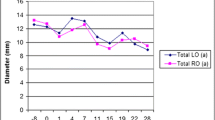Abstract
The most significant postoperative complication of spaying is bleeding from ovarian pedicles. In this study, all of the ovarian vessels were bilaterally ligated; then, ovaries were stimulated by gonadotropins. In a clinical trial and sequential control experiment, five healthy mixed-breed mature female dogs were randomly selected and kept under the new situation for 3 weeks. All ovarian vessels of the dogs were double ligated, bilaterally. For 13 weeks, blood samples, vaginal cytology, and ultrasound examinations continued weekly. All dogs received eCG (200 IU/dog, IM, 5 days) and hCG (500 IU/case IM, 5th day) 1 month after ovarian ligation. After 4 weeks, all dogs were ovariohysterectomized, and ovarian specimens were submitted for histopathological evaluations. Estradiol 17β and progesterone were assayed with ELISA kits. Estradiol concentration decreased after ligation and continued to decrease to the end of study (during 10 weeks). Estradiol concentrations were different before ligation and after hormone stimulation and ovariohysterectomy (P < 0.01). Progesterone concentration decreased suddenly after ligation and had a plateau during the study. Progesterone concentrations were different before ligation period and after ligation and hormone stimulation periods (P < 0.03). An ultrasonographical evaluation showed normal ovarian structures before ligation and ovarian adhesions to bursa and ovarian hyperechogenicity without the presence of active structures. Bleeding, congestion, primordial and primary follicle necrosis, and some degree of fibrosis were observed in the histopathological evaluations. Bilateral whole vessel ovarian ligation could inactivate dogs’ ovarian function during 8 weeks. So, we suggest ligation of whole vessels of dogs’ ovaries as an alternative method for ovariectomy.






Similar content being viewed by others
References
Adin CA (2011) Complications of ovariohysterectomy and orchiectomy in companion animals. Vet Clin North Am Small Anim Pract 41:1023–1039. https://doi.org/10.1016/j.cvsm.2011.05.004
Carpenter R (1973) Nylon bands used as ligatures and fixation devices in small animal surgery. 40th Am Anim Hosp Assoc Proc 1973:718–721
Da Mota Costa MR, de Abreu Oliveira AL, Ramos RM, de Moura Vidal LW, Borg N, Höglund OV (2016) Ligation of the mesovarium in dogs with a self-locking implant of a resorbable polyglycolic based co-polymer: a study of feasibility and comparison to suture ligation. BMC Res Notes 9:245. https://doi.org/10.1186/s13104-016-2042-2
Franco da Silva LA, Pinheiro Pales A, Soares Fioravanti MC, Pádua JT, da Silva OC, Gonçalves dos Santos KJ (2006) Anel de látex aplicado no pedículo ovariano de bezerras Nelore. Acta Sci Anim Sci 28(1):97–103
Frank LA, Rohrbach BW, Bailey EM, West JR, Oliver JW (2003) Steroid hormone concentration profiles in healthy intact and neutered dogs before and after cosyntropin administration. Domest Anim Endocrinol 24:43–57
Hossain MI, O’Shea JD (1983) The vascular anatomy of the ovary and the relative contribution of the ovarian and uterine arteries to the blood supply of the ovary in the guinea-pig. J Anat 137:457–466
Howe LM (2006) Surgical methods of contraception and sterilization. Theriogenology 66:500–509. https://doi.org/10.1016/j.theriogenology.2006.04.005
Kacsoh B (2000) Endocrine physiology. McGraw-Hill, New York
Kallini DF, Abdelmalik SW, Desouky AM, El-Beshbishy RA (2013) A comparative study between bilateral ligation of the ovarian and the uterine arteries on the structure and function of the ovary of adult white rabbit: histological and immunohistochemical study. Egypt J Histol 36:300–311. https://doi.org/10.1097/01.EHX.0000428966.85110.1a
MacPhail CM (2013) Surgey of the reproductive and genital systems. In: Fossum TW (ed) Small animal surgery, 4th edn. Elsevier, St. Louis, pp 780–855
Mogheiseh A, Nikahval B, Ahmadi N, Yazdanpanah R, Sadat Z, Nazifi S (2017) Bilateral ovarian pedicle ligation as an alternative to ovariectomy and ovarian response to eCG treatment. Comp Clin Pathol 26:197–202. https://doi.org/10.1007/s00580-016-2369-z
Murakami E, LSd C, Cardoso KCF, Miguel MP, Tavares DC, Honsho CS, FFd S (2014) Ovarian blood vessel occlusion as a surgical sterilization method in rats. Acta Cir Bras 29:218–223
Najafpoor A, Razi M, Najafi G, Khalilloo E, Abdollalizadeh G (2008) The effect of ligation of right ovarian artery on ovarian follicular function and PCOS generation in rats. J Anim Vet Adv 7:646–650
Nelson LR, Bulun SE (2001) Estrogen production and action. J Am Acad Dermatol 45:S116–S124
O’Leary JA (1980) Effects of bilateral ligation of the uterine and ovarian vessels in dogs. Int J Gynaecol Obstet 17:460–461
Olson PN, Mulnix JA, Nett TM (1992) Concentrations of luteinizing hormone and follicle-stimulating hormone in the serum of sexually intact and neutered dogs. Am J Vet Res 53:762–766
Perozo E, Valeris R, Riera M, Rodríguez JM, Cespedes R (2006) Arterial blood supply of ovaries in ewes and cows during estrous cycle. Rev Cient 16:472–480
Razi M, Najafpour A, Najafi G, Abdol Alizadeh G, Khaliloo E (2009) The effect of ligation of the ovarian artery on ovarian follicular function in rats. Int J Vet Res 3:87–94
Razi M, Akhtari K, Najafi A, Abdi K (2010) Effect of bilateral uterine artery ligation on follicular atresia in ovaries of mature female rabbits; histomorphometric and histochemical study. Iran J Reprod Med 8:101–110
Vilasagar S, Carrillo JF (2016) Laparoscopic ovarian vein ligation for treatment of pelvic congestion syndrome. J Minim Invasive Gynecol 23:S16. https://doi.org/10.1016/j.jmig.2016.08.049
Wehrenberg WB, Dierschke DJ, Wolf RC, Meyer RK (1979) The effect of ligating the ovarian and uterine arteries on ovarian function in cyclic rhesus monkeys. Biol Reprod 20:596–600
Funding
This study was funded by Shiraz University (grant number 94GCU3M154630).
Author information
Authors and Affiliations
Corresponding author
Ethics declarations
Conflict of interest
The authors declare that they have no conflicts of interest.
Ethical approval
All animal experiments were approved by the State Committee on Animal Ethics, Shiraz University, Shiraz, Iran (IACUC no. 4687/63). The recommendations of European Council Directive (86/609/EC) of November 24, 1986, regarding the standards in the protection of animals used for experimental purposes, were also followed.
Rights and permissions
About this article
Cite this article
Mogheiseh, A., Nikahval, B., Ahrari Khafi, M.S. et al. Effects of bilateral whole vessel ovarian ligation on dogs’ ovarian function and histopathology. Comp Clin Pathol 27, 1085–1091 (2018). https://doi.org/10.1007/s00580-018-2705-6
Received:
Accepted:
Published:
Issue Date:
DOI: https://doi.org/10.1007/s00580-018-2705-6




